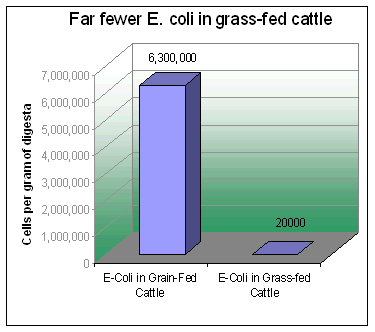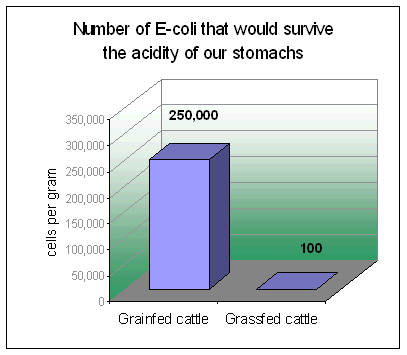|
[?]Subscribe To This Site
|
Grassfed Sirloin Steak Recipes Virtually Eliminate Risk of E-coli Infection
Unfortunately, feedlots are generally small, confined areas that can quickly become mud holes and manure pits. No wonder cattle confined in feedlots often arrive at the slaughterhouse filthy with mud and manure. How does a dirty cow affect you, your health, and your enjoyment of one of these sirloin steak recipes? When fecal matter from the hide touches the carcass during slaughter, contamination may occur. Does anyone want to even think about sitting down to dinner--even from a sizzling sirloin steak recipe--with meat from a dirty cow? Of course not. In contrast, grass fed cattle skip the feedlot. Since they are finished on pastures, they generally arrive at the processing plant cleaner than their feedlot cousins. Of course, every farm,including our own, has some mud and manure. Yet, the graphs and article below portray the dramatic difference. Mad cow disease is a frightening disease, but you have a greater risk of becoming ill and dying from the more familiar E. coli bacteria. When you eat grass-fed meat, you have a much lower risk of becoming infected with the bacteria. Why is this? First of all, work conducted at Cornell University has determined that grass-fed animals have far fewer E. coli than grain-fed animals.
What's more, the small amount they do have is much less likely to survive the natural acidity of our digestive tract--our first line of defense against infectious diseases.
Why this marked difference in the survival of the bacteria? Feeding grain to cattle makes their digestive tracts abnormally acidic. Over time, the E. coli in their systems become acclimated to this acid environment. When we ingest them, a high percentage will survive the acid shock of our digestive juices. By contrast, few E. coli from grass-fed cattle will survive because they have not become acid-resistant. When cattle are fed their natural diet of grass, our natural defenses are still capable of protecting us. Nonetheless, you should still follow all safe-handling recommendations when you prepare meat from grass-fed animals. It takes only a few E. coli bacteria to make us ill. But you can be assured that your risk of becoming infected is much, much lower.
Russell, J. B., F. Diez-Gonzalez, and G. N. Jarvis. "Potential Effect of Cattle Diets on the Transmission of Pathogenic Escherichia Coli to Humans" Microbes Infect 2, no. 1 (2000): 45-53. (Chart data extracted from this document. Excerpted with permission from www.eatwild.com, Jo Robinson's website.)
Now, take a deep breath, throw you head back and enjoy one of these grassfed sirloin steak recipes. They're safe, and you know why. Skewered Sirloin Tips2 pounds grassfed sirloin tip, cut into 1 1/4 inch cubes Roast Sirloin Steak with Black Peppercorn CrustSirloin steak recipes like this are for pepper lovers. 2 Tablespoons black peppercorns Preheat the oven to 550 degrees F. Place the peppercorns in the bottom of a 7-inch skillet and crush them with a small heavy saucepan. Coat both sides of the sirloin steak with the crushed peppercorns. Set a heavy 10-inch skillet with an ovenproof handle over moderately high heat for 1 minute. Add the olive oil and heat until almost smoking--about 1 minute more. Add the steak, cook for 30 seconds on one side, then turn. Transfer the skillet to the upper third of the oven and roast, uncovered, about 4 minutes for rare, 5 to 6 minutes for medium rare, 6 to 7 minutes for medium. Transfer the steak to a heated platter and slice thin. Add the green onions to the skillet and cook, stirring, over moderate heat for 30 seconds. Add the white wine and cook, uncovered, for 1 minute. Add the beef broth and simmer for 2 to 3 minutes, scraping up any browned bits, until 1/2 cup of liquid remains. Serve the sirloin steak with the sauce. Sirloin steak recipes go well with twice-baked potatoes. Serves 4
|
|





